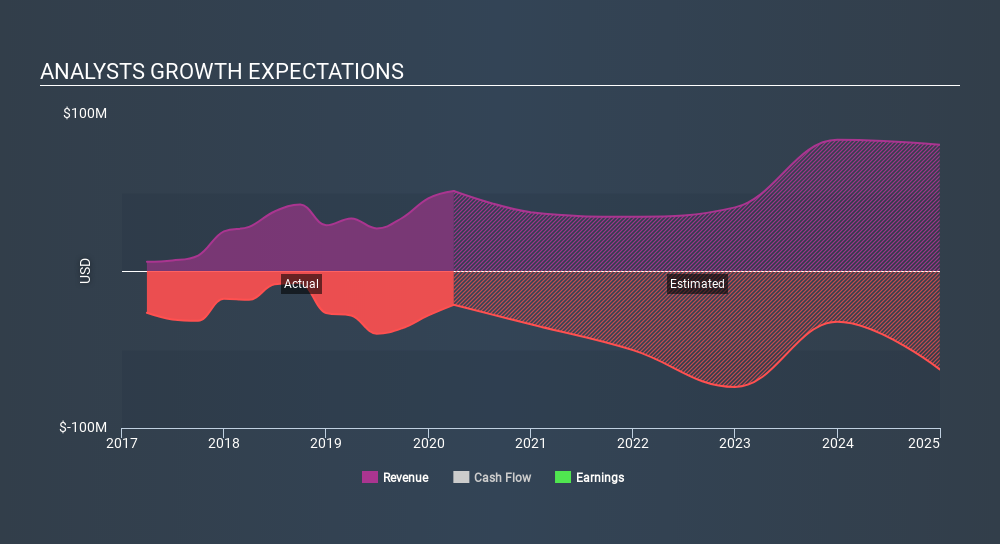- United States
- /
- Biotech
- /
- NasdaqCM:PIRS
Analysts Are Upgrading Pieris Pharmaceuticals, Inc. (NASDAQ:PIRS) After Its Latest Results

Pieris Pharmaceuticals, Inc. (NASDAQ:PIRS) just released its latest first-quarter results and things are looking bullish. The results were impressive, with revenues of US$13m exceeding analyst forecasts by 48%, and statutory losses of US$0.07 were likewise much smaller than the analysts had forecast. Following the result, the analysts have updated their earnings model, and it would be good to know whether they think there's been a strong change in the company's prospects, or if it's business as usual. We've gathered the most recent statutory forecasts to see whether the analysts have changed their earnings models, following these results.
View our latest analysis for Pieris Pharmaceuticals

Taking into account the latest results, the current consensus, from the five analysts covering Pieris Pharmaceuticals, is for revenues of US$37.4m in 2020, which would reflect a painful 27% reduction in Pieris Pharmaceuticals' sales over the past 12 months. Per-share losses are expected to explode, reaching US$0.62 per share. Yet prior to the latest earnings, the analysts had been forecasting revenues of US$35.5m and losses of US$0.71 per share in 2020. There's been a pretty noticeable increase in sentiment, with the analysts upgrading revenues and making a loss per share in particular.
It will come as no surprise to learn thatthe analysts have increased their price target for Pieris Pharmaceuticals 9.1% to US$8.00 on the back of these upgrades. That's not the only conclusion we can draw from this data however, as some investors also like to consider the spread in estimates when evaluating analyst price targets. Currently, the most bullish analyst values Pieris Pharmaceuticals at US$10.00 per share, while the most bearish prices it at US$5.00. Note the wide gap in analyst price targets? This implies to us that there is a fairly broad range of possible scenarios for the underlying business.
Looking at the bigger picture now, one of the ways we can make sense of these forecasts is to see how they measure up against both past performance and industry growth estimates. These estimates imply that sales are expected to slow, with a forecast revenue decline of 27%, a significant reduction from annual growth of 49% over the last five years. By contrast, our data suggests that other companies (with analyst coverage) in the same industry are forecast to see their revenue grow 24% annually for the foreseeable future. It's pretty clear that Pieris Pharmaceuticals' revenues are expected to perform substantially worse than the wider industry.
The Bottom Line
The most obvious conclusion is that the analysts made no changes to their forecasts for a loss next year. They also upgraded their revenue estimates for next year, even though sales are expected to grow slower than the wider industry. There was also a nice increase in the price target, with the analysts clearly feeling that the intrinsic value of the business is improving.
With that said, the long-term trajectory of the company's earnings is a lot more important than next year. We have estimates - from multiple Pieris Pharmaceuticals analysts - going out to 2024, and you can see them free on our platform here.
Don't forget that there may still be risks. For instance, we've identified 4 warning signs for Pieris Pharmaceuticals (1 is concerning) you should be aware of.
If you spot an error that warrants correction, please contact the editor at editorial-team@simplywallst.com. This article by Simply Wall St is general in nature. It does not constitute a recommendation to buy or sell any stock, and does not take account of your objectives, or your financial situation. Simply Wall St has no position in the stocks mentioned.
We aim to bring you long-term focused research analysis driven by fundamental data. Note that our analysis may not factor in the latest price-sensitive company announcements or qualitative material. Thank you for reading.
About NasdaqCM:PIRS
Pieris Pharmaceuticals
A biotechnology company, discovers and develops biotechnological applications.
Adequate balance sheet slight.
Market Insights
Community Narratives


